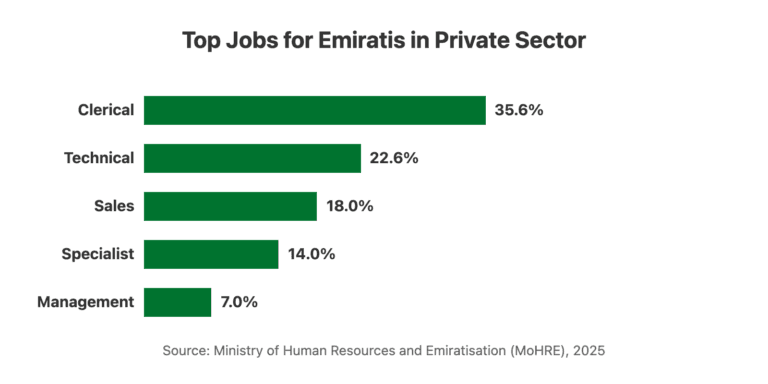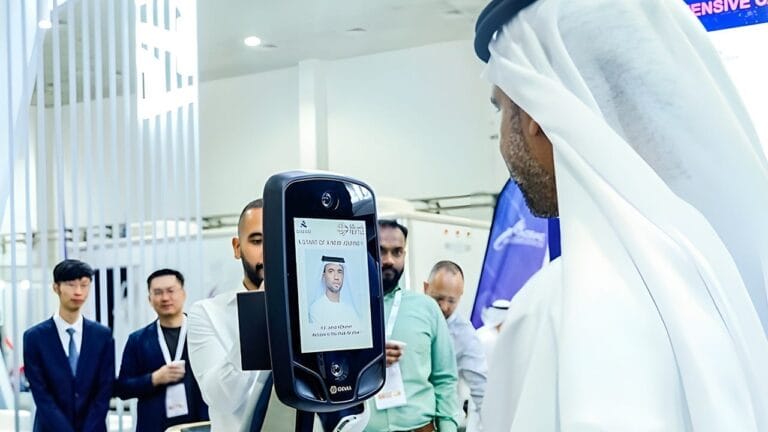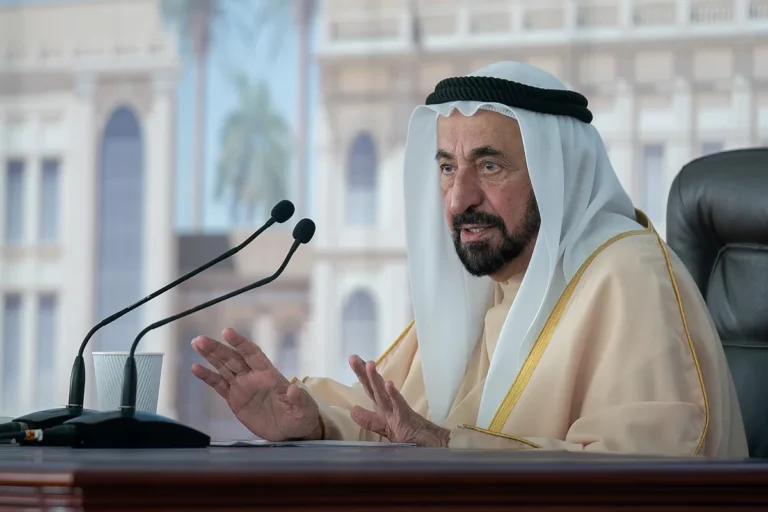In a landmark ceremony on June 9, 2025, His Highness Sheikh Mohammed bin Rashid Al Maktoum laid the foundation stone for the first station of the Dubai Metro Blue Line, marking the launch of the AED 20.5 billion Dubai Blue Line Metro project. Spanning 30 km and featuring 14 stations—including the world’s highest metro station—this expansion promises to transform commuting for over one million residents and expatriate workers by 2040.

Key Points
- Historic Milestone: On June 9, 2025, Sheikh Mohammed bin Rashid Al Maktoum officiated the foundation stone ceremony for the Blue Line’s first station, advancing Dubai’s public transport network.
- World’s Highest Metro Station: The Emaar Properties Station at Dubai Creek Harbour will rise to 74 m, designed by Skidmore, Owings & Merrill (SOM), becoming the tallest metro station globally.
- Project Scope: The AED 20.5 billion Blue Line Metro Dubai spans 30 km with 14 stations, connecting nine key areas and serving over one million residents by 2040.
- Timeline: Construction begins April 2025; operations start September 9, 2029—coinciding with the Metro’s 20th anniversary (9/9/2009 → 9/9/2029).
- Benefits for Workers: Faster commutes, lower transport costs, direct links to employment hubs (e.g., Ras Al Khor Industrial Area, International City), and thousands of jobs during construction and operation.
Table of Contents
Introduction & Strategic Context
Under the Dubai 2040 Urban Master Plan, the city aims for 80% of daily needs to be accessible within a 20-minute radius. The Dubai Metro Blue Line furthers this goal by linking major residential, educational, commercial, and industrial zones. Aligned with sustainability targets and economic diversification, the Blue Line addresses growing demand in neighborhoods such as International City, Academic City, and Dubai Creek Harbour.
Project Overview
- Length & Alignment: 30 km total (approx. 15.5 km underground, 14.5 km elevated).
- Stations: 14 new stations (9 elevated, 5 underground).
- Interchanges (3):
- Creek Station (Al Jaddaf) – interchange with Green Line
- Centrepoint Station (Al Rashidiya) – interchange with Red Line
- International City 1 Station – branch interchange hub
- Investment: AED 20.5 billion (contract awarded December 19, 2024).
- Construction Timeline: April 2025 – mid-2029; opening on September 9, 2029.
- Ridership & Capacity: ~200,000 daily passengers at launch (2030), rising to 320,000 by 2040; capacity of 46,000 passengers/hour/direction.
- Environmental Certification: First Dubai transport project achieving Platinum green building standards.
- Economic Return: Every AED 1 invested yields AED 2.60 by 2040; total societal benefits > AED 56.5 billion via reduced congestion, fuel savings, accident reduction, and environmental gains.
Read more: He Had ₹847, No Job & Broken English—Now He Earns 28,000 AED in Dubai!
Route & Map Details
Route Overview
The Blue Line follows a Y-shaped route, splitting at International City 1 Station:
- Branch A (Creek → Academic City):
- Creek Station (Al Jaddaf) – Green Line interchange
- Dubai Festival City Station
- Dubai Creek Harbour Station (Emaar Properties Station)
- Ras Al Khor Station
- International City 1 Station (interchange hub)
- International City 2 Station
- International City 3 Station
- Dubai Silicon Oasis Station
- Academic City Station
- Branch B (Centrepoint → International City 1):
- Centrepoint Station (Al Rashidiya) – Red Line interchange
- Mirdif Station
- Al Warqa Station
- International City 1 Station (merges into Branch A)
- Travel Time: Approximately 10–25 minutes end-to-end.
- Coverage & Significance: Connects key expatriate residential zones, education hubs, industrial areas, and emerging business districts.
Map Access
- Official RTA Interactive Map: Visit the RTA website for the interactive Dubai Metro Blue Line map once published.
- Map PDF Download: Search “Dubai Metro Blue Line map PDF download” on RTA’s portal when available.
- Dubai Metro App: Update/download the official app for trip planning including the Blue Line.
- Third-Party Integration: Google Maps transit layer will reflect the Blue Line close to launch.
Read more: Abu Dhabi to Dubai in 50 Minutes? Etihad Rail’s 2025 Game-Changer Will Shock UAE Commuters!
Station List & Design Highlights
Complete Station List
| Station Name | Location | Type |
|---|---|---|
| Creek Station | Al Jaddaf | Underground (Green Line interchange) |
| Dubai Festival City Station | Festival City | Elevated |
| Dubai Creek Harbour Station | Creek Harbour | Elevated (Emaar Properties Station) |
| Ras Al Khor Station | Industrial Area | Elevated |
| International City 1 Station | International City | Underground (Branch interchange) |
| International City 2 Station | International City | Elevated |
| International City 3 Station | International City | Elevated |
| Dubai Silicon Oasis Station | Silicon Oasis | Elevated |
| Academic City Station | Academic City | Elevated |
| Centrepoint Station | Al Rashidiya | Underground (Red Line interchange) |
| Mirdif Station | Mirdif | Elevated |
| Al Warqa Station | Al Warqa | Elevated |
| TBD Station | To be confirmed | TBD |
| TBD Station | To be confirmed | TBD |
World’s Highest Metro Station
- Emaar Properties Station (Dubai Creek Harbour):
- Height: 74 m (world’s highest metro station).
- Architect: Skidmore, Owings & Merrill (SOM).
- Design Concept: Golden cylindrical “gateway” with cultural motifs, blending heritage and futurism.
- Area & Capacity: 11,000 m² footprint; designed for 160,000 passengers/day (70,000 by 2040).
- Materials & Features: Jura limestone, bronze metal panels, granite flooring, glass ceilings for natural light, climate control, integrated retail/investment spaces.
- Sustainability: Platinum green building certification—energy efficiency, solar integration, recycled materials.
- Naming Rights: Secured by Emaar Properties for 10 years from 2029 inauguration.
Contractors, Tender & Award
Contractor Consortium
- MAPA & Limak (Turkey): Civil works—tunnels, elevated guideways, viaducts, and bridges (including the ~1,300 m Dubai Creek crossing).
- CRRC (China): Rolling stock supply, signaling systems, electrification, and systems integration.
- Consortium Role: End-to-end delivery: civil engineering, track laying, systems installation, testing, and commissioning.
Tender & Contract Award
- Tender Process: International competitive bidding emphasizing technical expertise, financial stability, track record in metro projects, and sustainability credentials.
- Contract Award: December 19, 2024, valued at AED 20.5 billion.
- Scope: Construction of 30 km alignment, 14 stations, metro bridge, rolling stock procurement, signaling, power supply, station fit-out, testing & commissioning.
Construction Timeline & Updates
- Foundation Stone Ceremony: June 9, 2025—Sheikh Mohammed bin Rashid Al Maktoum officiated.
- Construction Start: April 2025.
- Major Phases:
- 2025–2026: Site mobilization, utility relocations.
- 2026–2027: Tunneling for underground sections; elevated viaduct erection.
- 2027–2028: Station shell completion, track installation, systems integration.
- 2028–Mid 2029: Rolling stock arrival, signaling integration, trial operations.
- September 9, 2029: Official opening and start of passenger service.
- Progress Updates: Regular bulletins on RTA site and Dubai Media Office channels.
Read Latest News:
- Hiring Now: Accountant (UAE Experience Required) at Elite HR Consultancy in Dubai
- Dubai’s Biggest Visa Fraud Bust: 161 People Hit with Dh152 Million in Fines
- UAE temporarily halts visas for citizens from these 9 countries. Bangladesh on the list — Check details
- Hiring Now: Finance Manager at InZone in Dubai
- iPhone 17 launched in the UAE, residents rushed to get their hands on Apple’s latest release
- Hiring Now: Purchase Coordinator at a Hospitality Supplier in Dubai
Technical Specifications & Features
Rolling Stock & Automation
- Driverless Operation: Fully automated (GoA4), matching existing Red and Green Lines.
- Fleet Size: 28 new trains dedicated to Blue Line.
- Capacity & Frequency: High-capacity trains; ~2-minute frequency during peak hours.
- Maintenance: Advanced depot with predictive maintenance via IoT.
Signaling & Safety
- CBTC (Communication-Based Train Control): Enables close headways and high reliability.
- Platform Screen Doors: Present at all stations for passenger safety and climate control.
- Emergency Systems: Fire detection/suppression, evacuation routes, backup power.
- Passenger Information: Real-time displays, mobile integration for journey planning.
Station Amenities
- Accessibility: Elevators, ramps, tactile paths, facilities for People of Determination.
- Climate Control & Natural Light: Glass ceilings in elevated stations; efficient HVAC systems.
- Retail & Services: Convenience stores, cafés, kiosks integrated in concourses.
- Digital Payment: NOL card, contactless payments, mobile wallet support.
- Wayfinding: Multilingual signage (English/Arabic), digital kiosks.
Intermodal Integration
- Bus Feeder Services: Dedicated bays adjacent to stations for last-mile connectivity.
- Taxi & Ride-Hailing: Designated pickup/drop-off areas.
- Tram & Water Transport Links: Connections at interchange points where feasible.
- Micro-Mobility: Bicycle/scooter parking racks.
- Park-and-Ride: At select stations to encourage usage by commuters from outer areas.
Environmental & Sustainability Standards
- Green Building Certification: Platinum Category—first for Dubai transport project.
- Energy Efficiency: Solar panels on station roofs; LED lighting; energy-saving HVAC.
- Sustainable Materials: Recycled-content concrete; locally sourced Jura limestone; low-VOC finishes.
- Water Management: Greywater recycling for landscaping and cleaning.
- Waste Management: Construction-phase waste reduction; station recycling bins.
- Emission Reductions: Encourages modal shift from cars, reducing carbon footprint in line with UAE net-zero goals.
- Smart Systems: IoT monitoring for energy and maintenance to minimize resource usage.
Economic & Social Impact
Benefits for UAE Workers & Expatriates
- Reduced Commute Times: Direct links cut travel time to 10–25 minutes for commuters in International City, Mirdif, Al Warqa, and beyond.
- Cost Savings: Lower fares compared to taxis/private vehicles, easing financial burdens for low- to mid-income expatriate workers.
- Accessibility: Inclusive design benefits People of Determination and families.
- Job Accessibility: Improved access to employment hubs (Academic City, Ras Al Khor Industrial Area, Silicon Oasis).
- Reliability & Frequency: Predictable schedules enhance work-life balance and punctuality.
- Safety & Comfort: Climate-controlled stations and trains improve travel in UAE climate.
Property & Urban Development
- Property Value Uplift: Up to 25% increase near stations; spurs transit-oriented developments (TOD).
- Mixed-Use Developments: New residential, retail, and office projects around stations encourage urban regeneration.
- Community Growth: Enhanced connectivity supports new communities in emerging districts (Dubai Creek Harbour, Festival City).
- Investment Opportunities: Attracts investors to real estate and commercial ventures near stations.
Job Creation & Economic Returns
- Construction Jobs: Thousands in engineering, skilled labor, project management, technical roles during 2025–2029.
- Operational Jobs: Metro operations, maintenance, station staff, security, retail services after launch.
- Indirect Employment: Growth of retail, hospitality, services around stations.
- Economic Multipliers: AED 56.5 billion in societal benefits by 2040 via time savings, fuel reduction, accident decrease, and environmental health improvements.
- Tourism & Events: Better access to destinations (Dubai Festival City, Creek Harbour) boosts tourism revenue.
Future Extensions & Network Integration
- Phase 1 (2029): 14 stations serving nine key areas.
- Potential Phase 2 & Beyond: Extensions to Al Maktoum International Airport, Expo City, and connections to future Purple and Silver Lines as per RTA master plan.
- Intermodal Growth: Further integration with hyperloop studies, autonomous vehicles, and smart city transport initiatives.
- Monitoring: RTA publishes “Dubai Metro Blue Line extension” updates on feasibility and planning when available.
FAQs About the Dubai Metro Blue Line
What is the Dubai Metro Blue Line?
A new 30 km metro line expansion adding 14 stations to Dubai’s driverless network, connecting nine key districts.
When will the Dubai Metro Blue Line open?
Official opening date: September 9, 2029, coinciding with the 20th anniversary of the Dubai Metro’s launch.
When did construction start, and when will it be completed?
Construction commenced April 2025 after the June 9, 2025 foundation ceremony; completion by mid-2029, operations begin September 9, 2029.
How many stations are on the Blue Line?
Fourteen stations: 9 elevated, 5 underground, with 3 interchange stations (Creek, Centrepoint, International City 1).
What are the routes of the Dubai Metro Blue Line?
Branch A (Creek → Academic City): Creek (Al Jaddaf), Dubai Festival City, Dubai Creek Harbour, Ras Al Khor, International City 1, International City 2, International City 3, Dubai Silicon Oasis, Academic City.
Branch B (Centrepoint → International City 1): Centrepoint (Al Rashidiya), Mirdif, Al Warqa, merging at International City 1.
Where can I find the Dubai Metro Blue Line map?
Official interactive map on RTA’s website.
PDF download upon release via RTA.
Dubai Metro mobile app route planner.Who are the contractors for the Blue Line?
Consortium of MAPA & Limak (Turkey) for civil works, and CRRC (China) for rolling stock and systems; AED 20.5 billion contract awarded December 2024.
What is special about the Dubai Creek Harbour station?
Emaar Properties Station: world’s highest metro station at 74 m, designed by SOM, with premium materials and sustainable features.
How will the Blue Line impact commuters and property prices?
Commute times reduced (10–25 min end-to-end).
Lower transport costs vs. taxis/private cars.
Property values near stations may rise by up to 25%, encouraging transit-oriented development.Are there environmental benefits?
Yes: Platinum green building certification, energy efficiency, carbon emission reduction, sustainable materials, supporting UAE net-zero objectives.
What are the economic returns of the Blue Line?
Estimated AED 56.5 billion in societal benefits by 2040 through reduced congestion, fuel savings, accident reduction, and environmental improvements.
Will there be future extensions?
Potential extensions to Al Maktoum Airport, Expo City, and integration with Purple/Silver lines; RTA to announce feasibility studies and plans.
How can UAE workers stay updated on progress?
Follow RTA official updates on rta.ae, Dubai Media Office announcements, and major news outlets (Gulf News, Khaleej Times). Bookmark UAELabourLaw’s news section.
What is the Dubai Metro Blue Line contract value?
AED 20.5 billion.
Who designed the world’s highest station on the Blue Line?
Skidmore, Owings & Merrill (SOM).
How many trains will operate on the Blue Line?
28 new driverless trains dedicated to Blue Line operations.
What intermodal connections will the Blue Line have?
Bus feeder services, taxi stands, tram/water transport links, bicycle/scooter parking, park-and-ride facilities at select stations.
Where can I download the Dubai Metro Blue Line map PDF?
From RTA’s website once officially released; search “Dubai Metro Blue Line map PDF download” on rta.ae.
The Dubai Metro Blue Line is a transformative, fully informative initiative set to open on September 9, 2029. With 30 km of new track, 14 stations—including the world’s highest station—and advanced driverless technology under Platinum sustainability standards, it promises significant benefits for UAE workers and expatriates: reduced commute times, cost savings, better job access, and boosted property markets. This guide covers every aspect—route, map, stations, contractors, timeline, technical features, environmental credentials, economic impacts, and an extensive FAQ.






Pingback: UAE Expands Delivery Worker Protection With 10,000 Air-Conditioned Rest Stations - UAE Labour News
Pingback: Saudi Arabia Hits Reset On NEOM’s ‘The Line’ As Costs Surge And Job Cuts Loom - UAE Labour News